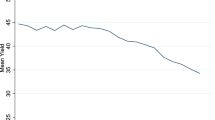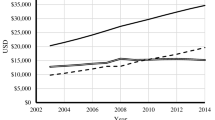Conclusions
Using the same universities with high-quality sports programs studied by McCormick and Tinsley, this paper qualifies their conclusion that big-time football enhances the academic mission through an advertising effect. While the advertising effect of an established big-time football winning tradition may attract a higher quality student to a university, there is a cost for some students once they enroll. Consistent with the adverse effect on output of faculty publications found in the Shughart, Tollison, and Goff study, this paper offers evidence that athletic success comes at the expense of some students who fail to graduate. Faced with the decision to study or engage in entertainment, the opportunity cost to students is higher when their football program is successful. If the football team is nationally ranked, there is greater incentive to talk football in the dorm, attend home games, cut Friday classes to take road trips to away games, including bowl games, and in general put off studying. In contrast, the evidence suggests that a big-time basketball program is unrelated to the graduation rate.
Similar content being viewed by others
References
“Graduation Rates of Athletes and Other Students at Division I Colleges,”The Chronicle of Higher Education, March 27, 1991, pp. A39–44.
Comparative Guide to American Colleges, 12th ed., Edited by James M. Cass and Max Birnbaum, New York, NY: Harper & Row, 1984.
Keeping Faith with the Student-Athlete: A New Model For Intercollegiate Athletics, Report of the Knight Foundation Commission on Intercollegiate Athletics, March 1991.
Lederman, Douglass. “College Athletes Graduate at Higher Rate Than Other Students, but Men's Basketball Players Far Behind, A Survey Finds,”The Chronicle of Higher Education, 37, 28, March 27, 1991, pp. A1, A39–44.
McCormick, Robert E.; Tinsley, Maurice. “Athleticsversus Academics? Evidence from SAT Scores,”Journal of Political Economy, 95, October 1987, pp. 1103–16.
Shughart, II, William F.; Tollison, Robert D.; Goff, Brian L. “Pigskins and Publications,”Atlantic Economic Journal, 14, July 1986, pp. 46–50.
“The Annual Report on the Economic Status of the Profession,” 1984–85,Academe, 71, March–April 1985, pp. 22–71.
The Statistical Abstract of the United States, 1991, 111th ed., Washington DC: GPO, U. S. Department of Commerce.
Tucker, III, Irvin B.; Amato, Louis, “Does Big-Time Success in Football or Basketball Affect SAT Scores?”Economics of Education Review, forthcoming.
Author information
Authors and Affiliations
Rights and permissions
About this article
Cite this article
Tucker, I.B. The impact of big-time athletics on graduation rates. Atlantic Economic Journal 20, 65–72 (1992). https://doi.org/10.1007/BF02300088
Issue Date:
DOI: https://doi.org/10.1007/BF02300088




